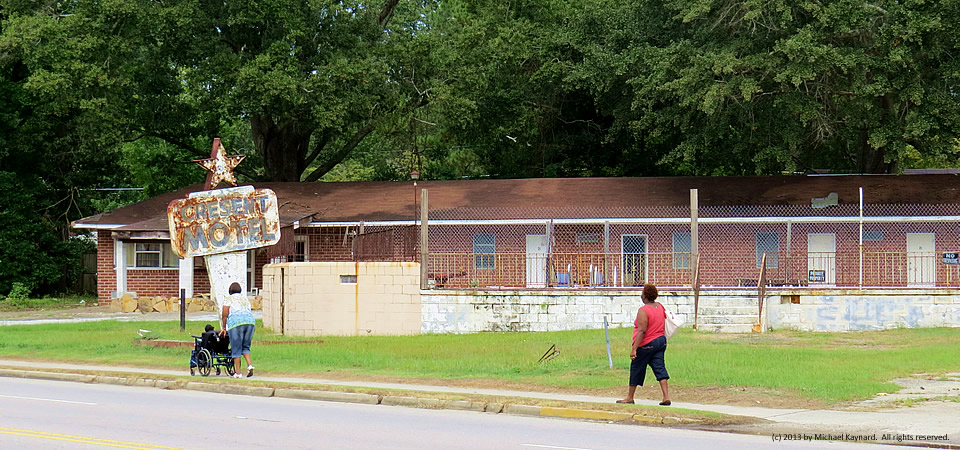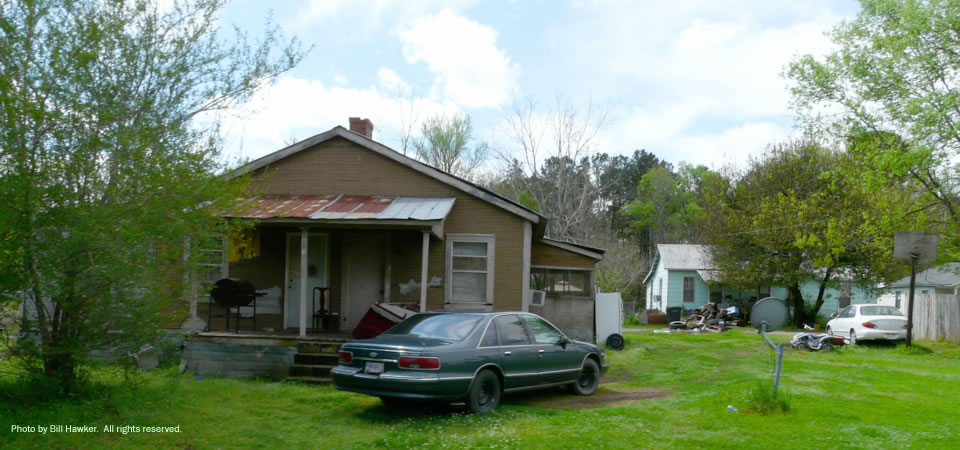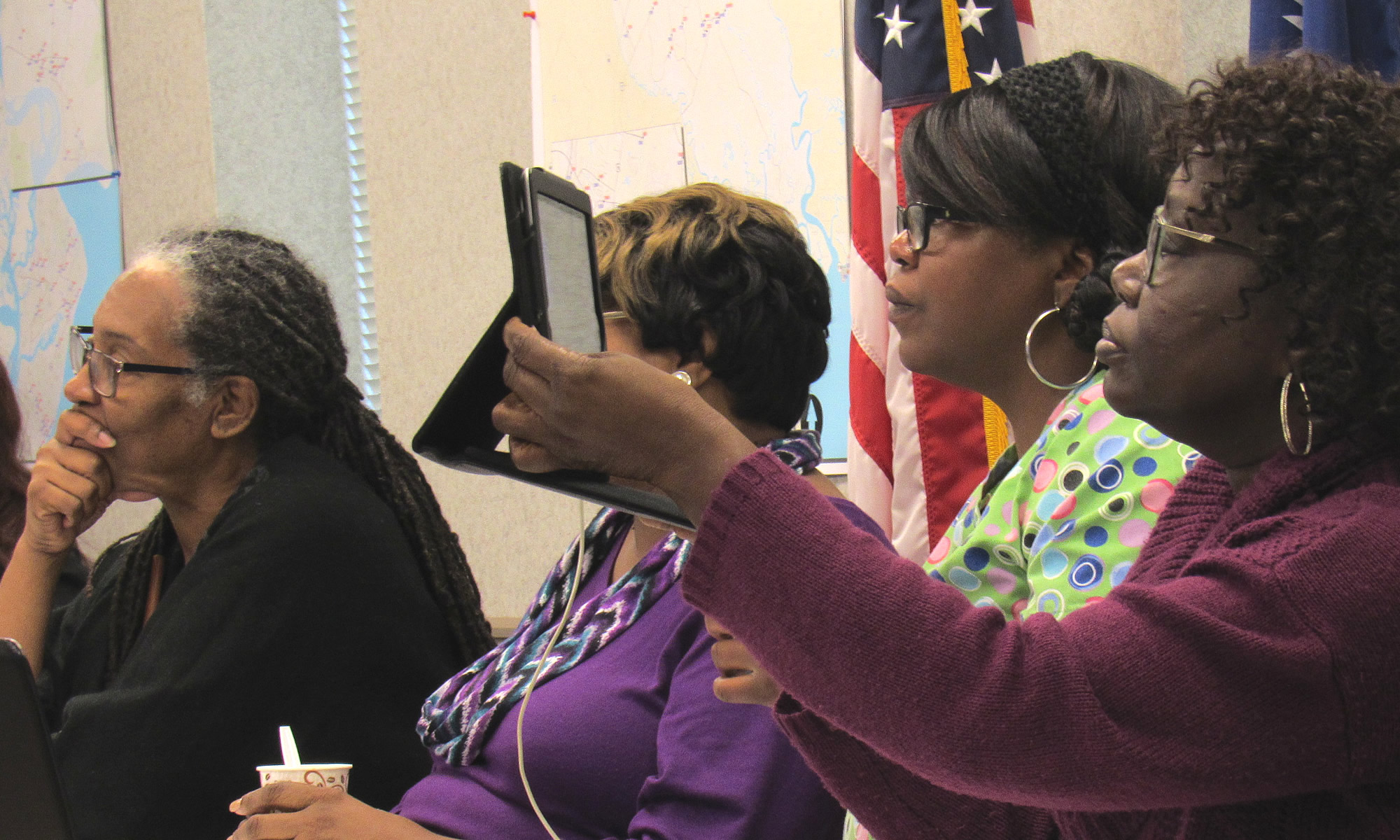Mike Switzer of SCETV Radio’s S.C. Business Review interviews the Center’s Andy Brack on how the Southeastern United States could become a much more powerful economic engine if it could figure out a way to keep its best and brightest people from continuing to abandon its poverty-stricken rural communities. Brack says the affected areas combine to create a huge crescent-shaped region across the south that his organization refers to, in fact, as the Southern Crescent.
Florence paper spotlights Center
The Florence (S.C.) Morning News profiled the Center’s work in a story about a Dec. 5 speech by president Andy Brack to the Florence West Rotary Club about the Southern Crescent project.
“Brack believes that by pooling smart people together, his group can do three important things to improve the problems of the South: work to tell people about the problems that exist, work with nonprofits and foundations to fund research and studies and work with the White House to get a special study commission appointed to recommend federal and state policies to raise the standard of living.”
 The story also reported that improving the quality of life was something that should be important to everyone who lived in it, including folks in the Pee Dee region around Florence.
The story also reported that improving the quality of life was something that should be important to everyone who lived in it, including folks in the Pee Dee region around Florence.
“Number one, as Southerners, we don’t take the easy way out. Number two, I think there are some economic justice issues here that a lot of you have a good quality of life, but we have to remember that there are 20 to 30 percent of people in rural counties that don’t have a good quality of life.
“There is also a moral component to this in that we are a wealthy country and we need to do a little more to leave this place better than we found it. Quite frankly, if we start taking care of all of these areas that drag us down, the South will improve its image.”
Brack: Crescent South needs attention
Published in the Atlanta Journal-Constitution
By Andy Brack
There’s a vitality that runs throughout metropolitan Atlanta. Expensive cars are ubiquitous around Lenox Square. Neighborhoods in bedroom communities in Gwinnett and Cobb counties have good schools, libraries and a pretty good quality of life, despite some reminders of the Great Recession and, of course, traffic.
 Vivacity, however, is harder to spot in a swath of agricultural Georgia that stretches across the middle of the Peach State, a rural sash of poverty where economic opportunity is tougher to find. The busiest place around might be a convenience store, as is the case in Leary in Calhoun County. Across the street is a full city block that has been abandoned. A couple of empty houses along Depot Street have been painted green or rusted red just to make them look less dilapidated.
Vivacity, however, is harder to spot in a swath of agricultural Georgia that stretches across the middle of the Peach State, a rural sash of poverty where economic opportunity is tougher to find. The busiest place around might be a convenience store, as is the case in Leary in Calhoun County. Across the street is a full city block that has been abandoned. A couple of empty houses along Depot Street have been painted green or rusted red just to make them look less dilapidated.
Across the South, from Tidewater Virginia through the eastern Carolinas along I-95, through the middle of rural Georgia and Alabama and to the Mississippi Delta, about 4 million people live in economically distressed counties. On a map, the area is crescent-shaped. It has higher rates of poverty, unemployment, single-parent households, chlamydia, obesity and diabetes. It’s easy to see that these areas correlate with another map — that of where enslaved people lived in 1860.
This “Southern Crescent” is a clear remnant of plantation life, a region that has been the soft underbelly of the Deep South for generations. Today, 150 years after the Civil War, it’s time for the Crescent to start receiving the same attention that Appalachia did in the 1960s War on Poverty.
It’s not all doom and gloom in Crescent counties. Lots of people have good lives. Some forward-looking communities have taken extra steps to plan and innovate. In recent years, Vidalia in South Georgia has branded itself as the go-to place for sweet, delicious onions. Prosperity shows throughout the town, but even today, 25 percent of the people in Toombs County live in poverty.
To focus attention on endemic poverty throughout the Crescent counties, the Center for a Better South offers a Web site — SouthernCrescent.org — to showcase life in the region. We hope to bring together nonprofits and foundations to fund research and studies on how to coordinate better and smarter delivery of services to infuse more dynamism in the region. The center encourages the White House to create a special national study commission to recommend federal and state policies to raise living standards and promote opportunity.
This effort may not cost a lot of money. If various state and federal government bureaucracies get out of their comfort zones and work with engaged rural communities, they can figure out ways to create more economic opportunities.
Ride the roads of Crescent counties in Georgia. It’s clear that rural Southerners want more opportunities for their counties. Now is the time to get moving so they don’t get left behind even more.
Andy Brack is president of the Center for a Better South (bettersouth.org) based in Charleston, S.C.
Better South data used for N.C. story
 The Daily Tar Heel, the student newspaper of the University of North Carolina, used the recent Better South 2013 Briefing Book on the South as the foundation for an Oct. 16 story that looked at how the state could have high unemployment and poverty rates and more economic growth than many states.
The Daily Tar Heel, the student newspaper of the University of North Carolina, used the recent Better South 2013 Briefing Book on the South as the foundation for an Oct. 16 story that looked at how the state could have high unemployment and poverty rates and more economic growth than many states.
“According to the think tank’s report, North Carolina is ranked sixth in unemployment and 17th in highest state tax burden. The report also listed North Carolina as 11th for economic growth and the fourth for the best state for business.
“Ferrel Guillory, UNC journalism professor and an expert in Southern politics, attributes the gap between the state’s roaring economy and unemployment increase to the change in the industries that drive the economy.
The story went on to quote Andy Brack, the Center’s president:
“Despite North Carolina’s high unemployment and a high state tax burden, Andy Brack, president of the Center for a Better South, said North Carolina still ranks better than other southern states including Alabama, South Carolina and Arkansas.
“’North Carolina has a lot of work to do to reduce unemployment,’ he said. ‘It’s doing pretty well in providing a good business climate.’”
Crescent profiled in Charleston newspaper
Excerpted from an Oct. 13, 2013, story in The (Charleston, S.C.) Post and Courier by Robert Behre:
Charleston-based center tries to tackle problems of the Southern Crescent
It could be the legacy of slavery or the more recent struggles facing family farms or rural areas’ loss of political clout.
In all likelihood, it’s some combination of all three — and possibly other factors as well.
Andy Brack, a self-employed journalist and head of the nonprofit Center for a Better South, is trying to call attention to the unique challenges facing this area, which he refers to as the “Southern Crescent.”
Brack said he never thought much about what lies beyond South Carolina’s so-called “Corridor of Shame.” The corridor — a wide swath around Interstate 95 — took its name from a 2006 documentary about the state’s most impoverished and struggling public schools.
As he studied maps, however, Brack realized the Palmetto State is not unique and that the corridor extends hundreds of miles beyond its state lines.
And he began an effort to raise awareness about its existence, awareness that he hopes will lead to solutions.
“We have a moral imperative to do something to reduce high rates of poverty, unemployment, disease and other conditions in the crescent,” he said. “If we deal with these, that will bolster the South’s reputation, lead to more business and improve our entire region.”
Sagging Southern Numbers
The South has:
- Roughly 25 percent of the U.S. population.
- Eight of the nation’s 10 poorest states (Miss., La., Ky., Ga., Ala., Ark., S.C. and N.C.)
- Seven of the nation’s 10 states with lowest graduation rates from public high school (Miss., S.C., La., Ga., Fla., Ala. and Ark. )
- Seven of the nation’s 10 states with lowest median household income (Miss., Ark., Ala., Ky., Tenn., La. and S.C.)
- Four of the nation’s 10 states with the highest crime rates (Tenn., S.C., La., and Fla.)
- Four of the nation’s 10 states with the highest unemployment in August 2013 (Ga., N.C., Miss. and Tenn.)
- Two of the nation’s 10 states with lowest 2012 voter participation (Ark. and Tenn.)
- Between five and eight of the nation’s 10 states with the highest rates of diabetes (8), high blood pressure (7), obesity (6) and infant mortality (5).
Source: 2013 Briefing Book on the South, October 2013. (which defines the South as these 11 states: Ala., Ark., Fla., Ga. Ky., La., Miss., N.C., S.C., Tenn. and Va.)
Southern Crescent profiled by Charleston newspaper

Excerpted from an Oct. 13, 2013, story in The (Charleston, S.C.) Post and Courier by Robert Behre:
Charleston-based center tries to tackle problems of the Southern Crescent
It could be the legacy of slavery or the more recent struggles facing family farms or rural areas’ loss of political clout.
In all likelihood, it’s some combination of all three — and possibly other factors as well.
Andy Brack, a self-employed journalist and head of the nonprofit Center for a Better South, is trying to call attention to the unique challenges facing this area, which he refers to as the “Southern Crescent.”
Brack said he never thought much about what lies beyond South Carolina’s so-called “Corridor of Shame.” The corridor — a wide swath around Interstate 95 — took its name from a 2006 documentary about the state’s most impoverished and struggling public schools.
As he studied maps, however, Brack realized the Palmetto State is not unique and that the corridor extends hundreds of miles beyond its state lines.
And he began an effort to raise awareness about its existence, awareness that he hopes will lead to solutions.
“We have a moral imperative to do something to reduce high rates of poverty, unemployment, disease and other conditions in the crescent,” he said. “If we deal with these, that will bolster the South’s reputation, lead to more business and improve our entire region.”
Sagging Southern Numbers
The South has:
- Roughly 25 percent of the U.S. population.
- Eight of the nation’s 10 poorest states (Miss., La., Ky., Ga., Ala., Ark., S.C. and N.C.)
- Seven of the nation’s 10 states with lowest graduation rates from public high school (Miss., S.C., La., Ga., Fla., Ala. and Ark. )
- Seven of the nation’s 10 states with lowest median household income (Miss., Ark., Ala., Ky., Tenn., La. and S.C.)
- Four of the nation’s 10 states with the highest crime rates (Tenn., S.C., La., and Fla.)
- Four of the nation’s 10 states with the highest unemployment in August 2013 (Ga., N.C., Miss. and Tenn.)
- Two of the nation’s 10 states with lowest 2012 voter participation (Ark. and Tenn.)
- Between five and eight of the nation’s 10 states with the highest rates of diabetes (8), high blood pressure (7), obesity (6) and infant mortality (5).
Source: 2013 Briefing Book on the South, October 2013. (which defines the South as these 11 states: Ala., Ark., Fla., Ga. Ky., La., Miss., N.C., S.C., Tenn. and Va.)
Crescent releases new video
Video: Promoting opportunity (2013)
You can click the image below to see a four-minute video from 2013 that the Southern Crescent, an impoverished area that stretches from Virginia through South Carolina and then swings over to the Mississippi Delta.
It highlights a dozen maps of the area — maps that tell quite a story.
- Let us know what you think. (Video added 10/3/2013).
SOURCES
Here are the sources for the maps that appear in the October 2013 video for the Southern Crescent project:
- POVERTY: Percentage of adults 18-64 living in poverty, ACS, five-year average, 2010, Census.
- POPULATION, white: Total population, white, Census 2010.
- POPULATION, black: Total population, Black or African American alone, Census 2010.
- HOUSEHOLDS: Family households, female householders, no husband present, Census 2010.
- HOUSEHOLD INCOME: Median household income, ACS 2010, 5 year estimate, Census.
- LOW INCOME: Household income, less than $10,000, ACS 2006-2010, Census.
- EDUCATION: Population 25 and over with less than a high school education, ACS 2006-10, Census.
- SLAVERY: Slave population, 1860 Census.
- UNEMPLOYMENT: Unemployment rates by county, August 2012 to July 2013 averages, U.S. Bureau of Labor Statistics.
- ELECTION: 2012 presidential election results, by county. Article and map via Wikipedia.
- HEART DISEASE: Death rate per 100,000 people, age 35+, all race, all gender, 2008-10, National Vital Statistics System, National Center for Health Statistics, Centers for Disease Control. Online: http://nccd.cdc.gov/DHDSPAtlas/viewer.aspx
- DIABETES: Age-adjusted estimates of the percentage of adults with diagnosed diabetes, 2010. Centers for Disease Control and Prevention: National Diabetes Surveillance System. Available online at: http://apps.nccd.cdc.gov/DDTSTRS/default.aspx. Retrieved 9/18/2013.
- OBESITY: Age-adjusted estimates of the percentage of adults who are obese, 2008 data, Centers for Disease Control. Map via MaxMasnick.com.
- CHLAMYDIA: Chlamydia–Rates by county, United States, 2010. Centers for Disease Control and Prevention, National Center for HIV/AIDS, Viral Hepatitis, STD, and TB Prevention, Division of STD Prevention. Online at: http://www.cdc.gov/std/stats10/figures/4.htm
New poverty study challenges assumptions
Better South President Andy Brack discussed a new Harvard poverty study that shows poor upward mobility in the Southern Crescent region in the recent issue of Statehouse Report. From the commentary:
For Americans trying to escape poverty, location matters – just like in real estate. And if you live in the Deep South, it’s harder to escape than about anywhere else in the country, just as generations of us have known.
Throughout every area of South Carolina, jumping from the bottom quintile of income to the middle class or beyond is tough, according to a new Harvard study making waves in policy circles.
In the Columbia area, for example, a child has a 36.6 percent chance of rising out of the bottom quintile of income and a 4.2 percent chance of leaping from the bottom to the top quintile. Those probabilities are among the lowest in the nation and not much different from the number for Greenville, where kids have a 37.7 percent chance to escape poverty and a 4.9 percent chance to be among the nation’s highest earners. Researchers found similar low numbers for Memphis, Charlotte, Atlanta and Raleigh.
“Where you grow up matters,” Harvard economist and researcher Nathaniel Hendren told The New York Times. “There is tremendous variation across the U.S. in the extent to which kids can rise out of poverty.”
The new study is drawing attention for what it found, but also for what it didn’t find. Researchers crafted the study by analyzing millions of anonymous earnings records to measure intergenerational mobility, or how children move across income levels compared to their parents.
The research team was interested in whether tax breaks and credits, such as the Earned Income Tax Credit, were correlated to high mobility, or the ability of kids to move out of poverty. They found some correlation between local tax rates and mobility, but a weaker correlation between state EITC policies and mobility.
So they looked for other factors to explain why some areas had high mobility out of poverty and others, like Southern states, had low mobility. They identified four correlations, but emphasized they were not causes:
Family structure. “The share of households with kids that are headed by a single mother is a very strong predictor of mobility,” research associate Alex Olssen told Statehouse Report. The study indicated income mobility was higher in areas with more two-parent households.
Local middle class. The density that poor families are dispersed among mixed-income neighborhoods appear to be correlated. “Areas in which low income individuals were residentially segregated from middle-income individuals were also particularly likely to have low rates of upward mobility,” according to the study.
Better schools. Income mobility is higher when a metro area has better primary and secondary schools. Having an array of colleges and their tuition rates don’t appear to be as significant, according to study’s results.
Civic engagement. The more chances for civic engagement, including with religious and community groups, the better the upward mobility.
“Black Belt,” Bellamy, Ala.

The term “Black Belt” means different things to different people. For geographers, it means a swath of black topsoil that cuts through the middle of Alabama that was the foundation of cotton crops and an agricultural economy. For sociologists, though, it is a term that reflects a crescent-shaped region that includes the same area of Alabama, but stretches westward toward the Delta area and eastward through Georgia, hooking northerly to the Carolinas and Tidewater Virginia — the area we call the “Southern Crescent.”
The picture above is from Bellamy, Ala., and is representative of the poverty found throughout the Crescent. Bellamy, which has about 500 people, a post office and a health center, was several miles from the closest gas station or country store on our last visit to the area in 2009. Bellamy is in rural Sumter County, Ala., where 38 percent of the population lives at or below the federal poverty level.
- QuickFacts about Sumter County from the U.S. Census
- More on the “Black Belt”
- SIGN UP to get a photo from the Southern Crescent sent to you every other day by email.
Photo by Bill Hawker, Sydney, Australia, in March 2009 for the Center for a Better South. All rights reserved.




